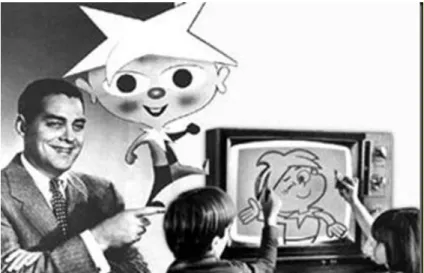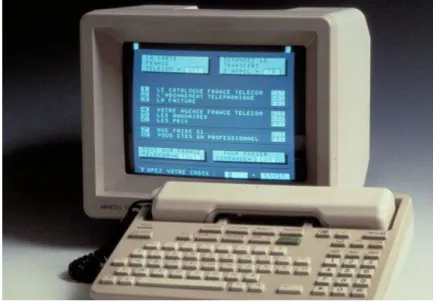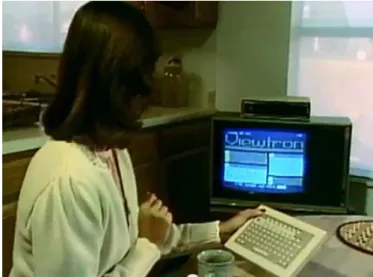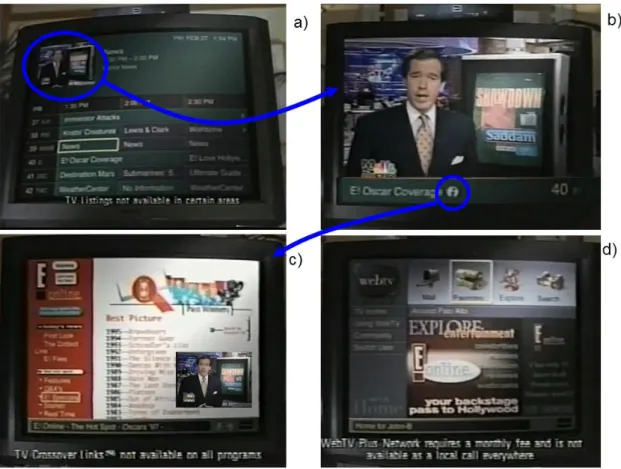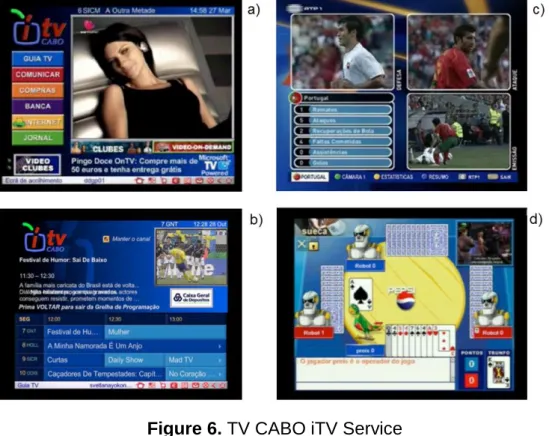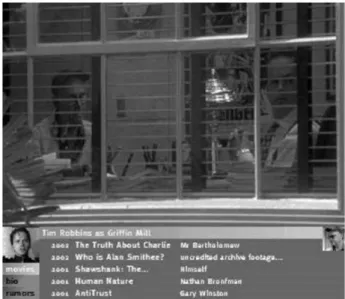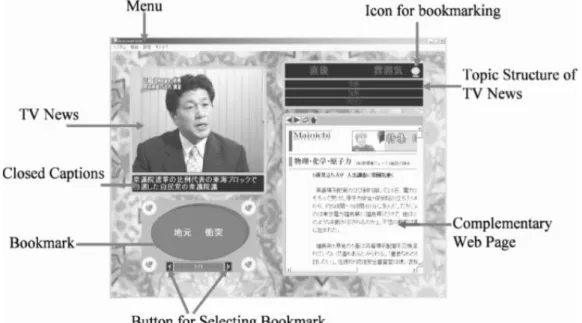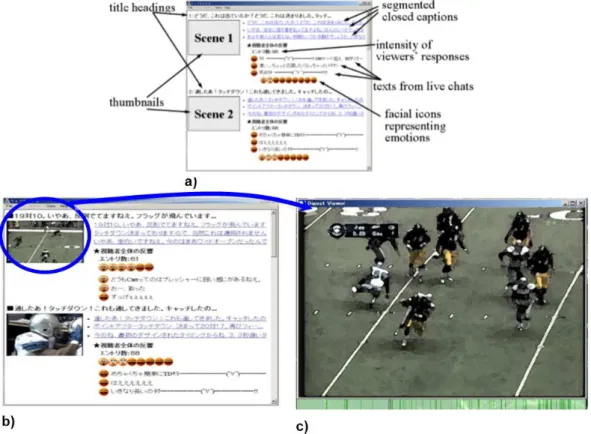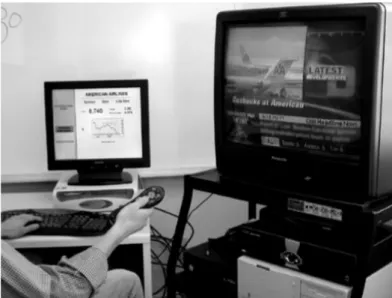UNIVERSIDADE DE LISBOA
FACULDADE DE CIÊNCIAS
DEPARTAMENTO DE INFORMÁTICA
Designing Personalized Video-Based Crossmedia
Informal Learning Environments Beyond iTV
Alcina Maria Narciso Prata
DOUTORAMENTO EM INFORMÁTICA
ESPECIALIDADE DE ENGENHARIA INFORMÁTICA
UNIVERSIDADE DE LISBOA
FACULDADE DE CIÊNCIAS
DEPARTAMENTO DE INFORMÁTICA
Designing Personalized Video-Based Crossmedia
Informal Learning Environments Beyond iTV
Alcina Maria Narciso Prata
Tese orientada pela Prof.ª Doutora Maria Teresa Caeiro
Chambel, especialmente elaborada para a obtenção do grau de
doutor no ramo de Informática, especialidade de Engenharia
Informática.
To my son, my gravity center, the light that lights up my steps along the way; to my parents for being always there for me independent of circumstances and to João, my lucky star!
In Portuguese:
Para o meu filho, meu centro de gravidade, a luz que ilumina os meus passos ao longo do caminho; para os meus pais por estarem sempre ao meu lado independentemente das circunstâncias e para o João, a minha estrelinha da sorte!
Acknowledgments
The biggest acknowledgement goes, without a doubt, to my advisor, Professor Teresa Chambel. Without her deepest insights, guidance, knowledge, scientific and ‘day life’ wisdom, without her example, tolerance, understanding and constant support and without her belief in my abilities (even when I doubted) nothing of this would be possible. Thank you so much for never giving up on me!
To Professor Nuno Guimarães (ISCTE) for his insights since the beginning of this thesis.
To Professor Piet Kommers (University of Twente, Nederlands) for being always so helpful and available.
To Professors Célia Quico (Lusófona University), Marco de Sá (FCUL), Ferraz de Abreu (University of Aveiro), Miguel Sales Dias (ISCTE/Microsoft), Manuel Damásio (Lusófona University), Carlos Serrão (ISCTE) and Dr João Saleiro, for sharing their own experience on related works and for their friendly support and encouragement.
To Professors Konstantinos Chorianopoulos (Ionian University, Greece), Lynn Pemberton (Brighton University, United Kingdom), Judith Masthoff (Brighton University, United Kingdom), Judy Zaichkowsky (Simon Fraser University, Canada), Stefan Agamanolis (MIT), Drª Ali e Drª Sheri Lamont (Microsoft) for contributing with their valuable insights and sharing their own experience on related works.
To Dr. Diogo Silva who contributed to part of this work. Thank you for your help with the prototypes development.
To LaSIGE and research colleagues from the project ImTV - On-Demand Immersive-TV for Communities of Media Producers and Consumers,
2010-2013, Reference: UTA-Est/MAI/0010/2009, supported by FCT through LASIGE Multiannual Funding who also partially supported this work.
To Professors Miguel Sales Dias, Leslie Bajuelos, Pedro Ramos, Luís Cavique, Pedro Faria Lopes and João Rato for believing in my work and supporting me along the process of getting my scholarship through their recommendation letters.
To the Polytechnic Institute of Setúbal, namely to the President Prof. Armando Pires, for approving my scholarship appliance. All of the work described in this thesis would be definitely hard to achieve without the financial support provided by Fundação para a Ciência e Tecnologia (scholarship SFRH/PROTEC/67727/2010), for which I am grateful.
To all the students and non-students that participated in the evaluation process, for being always so enthusiastic and participative, contributing with their own insights never avoiding criticizing and making suggestions that were very helpful in achieving such good results.
To my special friends Teresa Barreto, Florbela Fidalgo and Sónia Amador those that never let me down and were by my side, laughing and crying, through all these years. To all my friends I wish to thank their permanent support and words of encouragement.
Finally, but most importantly, to my son and my parents for their unconditional love and support. My son Martim for all the time that he silently played alone, in order not to disturb “mums work”… This is for you baby, with God’s help it will improve our lives!
To my parents for being always by my side in all circumstances, for all the love and care they gave me throughout all my life and all the strength and motivation during this work, encouraging me to reach higher.
To my mother, the one that never let me give up from anything. Thanks for your unconditional love, support and patience in every moment and step of the
way. Thanks for taking care of us every time I was working hard, every day, sometimes until dawn… I never heard a complaint from your lips or saw tiredness in your eyes. Thank you for being so powerful and such an inspiration.
To João Minhota, for being always there for me, patiently, helping me in all aspects of my live. Thank you for being so caring and supportive.
Abstract
Video is a very rich medium, in cognitive and affective terms, to convey information and support learning and entertainment like no other medium, and TV is a privileged way to watch it. However, by being traditionally watched in a more experiential and passive cognitive mode, TV and video are limited in their capacity to fully support learning so important in the lifelong learning era where learning is taking place in a wide variety of contexts and locations that calls for flexible environments. TV and video are limited in their capacity to fully support learning but may induce viewers to engage in more reflective modes, that can be supported to some extent by their adequate design, in interactive contexts and augmented by other media and devices, in diverse situations. The inclusion of iTV that has been gaining increasing attention from researchers, and practitioners, in the last few years, as part of rich and flexible crossmedia environments brings new opportunities in this respect.
This situation justifies our research main goal to efficiently and flexibly support users learning informal opportunities created in video-based crossmedia environments, taking into account the different cognitive modes, contexts of use and taking advantage of the diverse devices being used in order to have each device contributing with what it does best.
In order to illustrate, explore and validate our research, the eiTV application was conceptualized, prototyped and evaluated. It is capable to create video-based crossmedia informal learning environments, created as additional information to the video being watched, initially via iTV. These environments are accessed from iTV, PC and mobile devices (the most commonly used in crossmedia scenarios), depending on the preferred or most adequate device in each context of use.
Keywords: Crossmedia, Transmedia, iTV, Design, Video, Interaction, Informal Learning, Mobile Devices, Personalization.
Resumo – Portuguese Abstract
O Vídeo é um meio muito rico em termos cognitivos e afectivos, tanto para armazenar informação como para dar suporte à aprendizagem e entretenimento como nenhum outro. Desde cedo foram muitos os autores, dos quais Walt Disney terá sido provavelmente o mais conhecido, que lhe adivinharam um futuro risonho enquanto meio privilegiado em questões educativas. O vídeo é um meio tradicionalmente activo ou quente, induzindo uma atitude passiva ou fria nos utilizadores e, apesar de poder ser visto através de dispositivos diferentes, a verdade é que a TV continua a ser uma forma privilegiada para o ver. A TV apesar de utilizada (visualizada) num modo cognitivo mais experiencial e passivo (ou seja o modo que nos permite perceber e reagir aos acontecimentos de forma eficiente e sem esforço, o modo da percepção, entretenimento, motivação e inspiração) pode conduzir os telespectadores a modos cognitivos mais reflexivos e activos, em segundos (modo da cognição, do pensamento, da tomada de decisão, da razão). Não obstante poder conduzir os telespectactores a um modo cognitivo mais reflexivo, a TV é contudo limitada no que respeita a proporcionar um suporte adequado a este modo cognitivo, um modo muito importante na aprendizagem. Enquanto estão a ver um programa de TV, os telespectadores podem querer saber mais acerca de um determinado tópico. No entanto, podem preferir continuar num modo mais experiencial, o modo dominante quando se vê TV, e seguir mais tarde, possivelmente através de outro dispositivo e quando puderem envolver-se num modo cognitivo mais reflexivo, o caminho que os leva a saber mais sobre o referido tópico, ou podem optar por seguir esse caminho imediatamente.
A TV por si só não constitui um suporte adequado à reflexão, o modo cognitivo por excelência quando a aprendizagem é o objectivo. No entanto, apesar de não conseguir aumentar a reflexão humana neste sentido, a TV pode tornar-se numa poderosa ferramenta para reflexão quando devidamente aumentada. De facto, a televisão interactiva (iTV), dada a sua natureza, pode possibilitar aceder e interagir com a informação sobre o programa e tópicos relacionados que podem estar disponíveis como conteúdo de TV indexado e
referências para seguir e pesquisar. A história da iTV tem sido repleta de percalços que ditaram uma jornada de avanços e recuos. Mas a verdade é que, nos últimos anos, a iTV tem ganho cada vez mais atenção por parte de investigadores, operadores de TV e do público em geral, dado o seu potencial em termos de entretenimento, e também comunicação, saúde e aprendizagem, tornados possíveis através de avanços tecnológicos e um melhor design de interfaces e serviços. A iTV tem a vantagem de combinar o apelo e a audiência de massas da TV com a interactividade da web, permitindo novos serviços, dando aos telespectadores maior controle sobre aquilo que vêm e criando um ambiente novo e enriquecido. É por isso, na opinião de muitos investigadores e produtores, uma tecnologia que está a ser cada vez mais utilizada e portanto a ganhar o seu espaço. Esta convicção é claramente suportada pelo número de estudos de investigação que surgiram nos últimos anos. Alguns estudos identificaram o potencial da iTV para aumentar oportunidades de aprendizagem a partir de casa, em particular através de opções personalizadas e a necessidade de encontrar formas de utilizar a poderosa combinação da TV convencional e dos serviços interactivos, de modo a conduzir os telespectadores a ambientes de aprendizagem activos.
Outros dispositivos, como PCs e telemóveis, também evoluiram e são agora frequentemente utilizados para a visualização de vídeos. No entanto, estes dispositivos que implicam uma atitude ‘inclinada para a frente’ (lean forward) são mais adequados para suportar o modo reflexivo e mais activo dos utilizadores. Contrariamente, a TV (e o vídeo em especial) é caracterizada por implicar uma atitude ‘inclinada para trás’ (lean back), e tal como previamente referido, é mais adequada para suportar o modo cognitivo experiencial e passivo dos utilizadores. No entanto, os utilizadores podem alternar entre estes dois modos cognitivos em segundos, dependendo de diferentes tipos de factores internos e externos, e ambos são importantes para a cognição humana embora requeiram diferentes tipos de suporte tecnológico. Assim sendo, sistemas preparados para suportar mudanças nos modos cognitivos, em particular se baseados na utilização de dispositivos diferentes, são certamente mais flexíveis e apropriados às necessidades dos utilizadores. Simultaneamente, estamos a testemunhar um momento de transição, em que os velhos sistemas estão a ser utilizados de forma distinta e, nalguns casos, a
morrer e a dar lugar a novos. A tradicional cultura espectatorial está a dar lugar a uma cultura participativa. E neste contexto é importante que se refira que os avanços não ocorrem apenas porque a tecnologia evolui. É lícito dizer que a tecnologia evolui porque também as pessoas modificaram a sua forma de estar e de interagir requerendo cada vez mais tecnologias que suportem a sua ‘nova’ forma de estar. Cada vez mais as pessoas têm demonstrado propensão para a interactividade, para a partilha e para a utilização de dispositivos em simultâneo como por exemplo, usar o PC e dispositivos móveis para interagir com a TV e para partilhar conteúdos. A proliferação de novos dispositivos capazes de suportar as actividades humanas através de um espectro alargado de contextos de uso, tal como acontece na vida real, foi uma das maiores motivações para a integração dos dispositivos naquilo que se designou por sistemas crossmedia. Estes sistemas não estão limitados a um único dispositivo, tal como o telemóvel, PC ou iTV mas, ao invés, recorrem a alguns ou até a todos os dispositivos. Os sistemas crossmedia são muitas vezes referidos como multi-plataforma ou transmedia. No contexto do presente trabalho, uma aplicação, sistema ou ambiente crossmedia é aquele que se espande por vários dispositivos como parte de um sistema único, com uma estrutura de papeis e funcionalidades definidos para atingir objectivos específicos.
A par com a proliferação de sistemas crossmedia, o acesso global à informação e às tecnologias está a mudar a relação entre pessoas e conhecimento, e a tendência para a convergência, integração e co-existência de várias tecnologias está a criar novas oportunidades para a globalização das práticas de aprendizagem e comunicação. Devido à sua flexibilidade, os sistemas crossmedia são particularmente promissores no que respeita às oportunidades que criam em termos de comunicação, entretenimento, aprendizagem e outras actividades. Com a emergência da era da aprendizagem ao longo da vida, e considerando que a aprendizagem passará a ter lugar numa grande variedade de contextos, e locais e que a aprendizagem informal (a que tradicionalmente ocorre a partir de actividades diárias, normalmente de forma inesperada) tenderá a ser tão importante como a aprendizagem formal, necessitando por isso de ambientes flexíveis, pode dizer-se que os sistemas crossmedia são um auxiliar perfeito para lhes dar suporte.
No entanto, estes sistemas, bastante promissores devido às suas vantagens e potencialidades para criar ambientes ricos e flexíveis, enfrentam alguns desafios de desenho que podem afectar a eficiência da sua utilização. Essa situação justificou o principal objectivo de investigação desta tese que foi perceber como dar suporte, de forma eficaz e flexível, às oportunidades de aprendizagem informal, criadas em ambientes crossmedia centrados no vídeo, levando em conta os diferentes modos cognitivos, contextos de uso e tirando partido dos diferentes dispositivos utilizados.
De modo a alcançar o objectivo proposto, alguns desafios de investigação necessitaram de atenção especial, como por exemplo as questões conceptuais que se relacionam com: o uso de vários media e dispositivos com características diferentes, os diferentes contextos de uso, os aspectos cognitivos inerentes a cada media e dispositivo, bem como a continuidade e contextualização da experiência de utilização através de diferentes dispositivos em tempos e locais diferentes. Neste trabalho, estes desafios são apresentados e discutidos e, com base nisso, é descrita e sugerida uma framework conceptual que refere aspectos relevantes para o desenho, a partir de vídeo, e como resposta a necessidades de aprendizagem informais, de ambientes crossmedia personalizados para acesso a conteúdos.
Concluindo, este trabalho apresenta as seguintes contribuições:
Explora o que contribui para a análise, desenho, prototipagem e avaliação eficaz de aplicações e interfaces para serviços crossmedia flexíveis, baseados em vídeo, tirando o melhor partido de cada um dos dispositivos envolvidos. Com base na investigação efectuada e na experiência adquirida é proposta uma framework conceptual para análise, desenho, prototipagem e avaliação deste tipo de conteúdos.
Explora o que contribui para a análise, desenho, prototipagem e avaliação eficaz de aplicações e interfaces flexíveis para iTV. Com base na investigação efectuada e na experiência adquirida é proposta uma framework.
Como forma de exploração, validação e prova de conceito, foi desenvolvida uma aplicação, à qual foi dado o nome de eiTV, desenhada e avaliada de modo a ilustrar, explorar e validar a nossa investigação. A aplicação eiTV é capaz de criar ambientes crossmedia de aprendizagem informal, criados
como informação adicional ao vídeo que está a ser visto a partir desse mesmo vídeo e, inicialmente a partir da iTV. Estes ambientes podem ser acedidos via iTV, PC e dispositivos móveis, dependendo do dispositivo preferido ou do mais adequado a cada contexto de uso em qualquer altura, quer para visualização quer para partilha.
Importa ainda referir que, mais do que um meio para experimentação e validação da investigação, a intenção era que a aplicação eiTV pudesse também ser vista como um novo tipo de serviço com interesse para uso generalizado em contextos crossmedia emergentes.
A avaliação, cujos resultados foram considerados bastante positivos e animadores, é igualmente apresentada e discutida, permitindo validar os contributos e identificar direcções futuras.
Palavras Chave: Crossmedia, Transmedia, iTV, Design, Video, Interacção, aprendizagem informal, dispositivos móveis, personalização.
Contents
1. Introduction ... 1
1.1.Objectives and Approach ... 4
1.2.Thesis Contributions ... 6
1.2.1. eiTV Application ... 7
1.2.2. Publications ... 9
1.3.Research Context ... 15
1.4.Thesis Structure ... 16
2. State of the Art ... 17
2.1. Media, Devices and Internet ... 17
2.1.1. Characteristics, Evolution and Trends ... 17
2.1.2. Adoption and Use Patterns ... 28
2.1.3. Discussion ... 36 2.2.Crossmedia ... 37 2.2.1.Motivation ... 37 2.2.2.Definition ... 38 2.2.3.Advantages ... 40 2.2.4.Challenges ... 41 2.3.Supporting Learning ... 46 2.4.Related Work ... 48
2.4.1. Access to Information and Socialization through iTV: an Historical Perspective ... 48
2.4.2. TV and Web ... 62
2.4.3. Crossmedia Systems ... 68
2.4.4. Second Screen Systems ... 83
2.4.5. Discussion ... 86
2.5.Summary ... 87
3. Conceptual Framework ... 89
3.1. User Centered Design in HCI and Crossmedia ... 89
3.1.1. Involving the User in the Design Process ... 90
II
3.2. Crossmedia Analysis and Design ... 93
3.2.1. Media and Cognition ... 94
3.2.2. Cognitive Theory of Multimedia Learning ... 95
3.2.3. Supporting Crossmedia Interaction ... 97
3.2.4. Devices Interfaces Analysis and Design ... 109
3.3. Crossmedia Prototyping ... 124
3.3.1. Interactive Television Prototyping ... 126
3.3.2. Mobile Devices and Web in PC Prototyping ... 128
3.4. Crossmedia Evaluation Framework ... 130
3.4.1. Viewers Characterization and Selection ... 130
3.4.2. Formative and Final Evaluation ... 131
3.4.3. Experts Usability Evaluation ... 135
3.4.4. Viewers Usability Evaluation ... 136
3.4.5. Affective Evaluation ... 140
3.5. Summary ... 144
4. eiTV Crossmedia Application ... 145
4.1. Global Analysis and Requirements Gathering ... 146
4.1.1. TV Genres and Programs ... 146
4.1.2. Related Websites Analysis ... 147
4.1.3. Viewers Characterization and Selection ... 148
4.1.4. Crossmedia Requirements and Design Dimensions ... 152
4.2. eiTV First Generation: Web Content from iTV ... 153
4.2.1. Analysis and Design ... 154
4.2.2. Prototyping ... 157
4.2.3. Evaluation ... 174
4.2.4. Discussion ... 184
4.3. eiTV Second Generation: Going Beyond iTV Video in the Cloud .... 185
4.3.1. Analysis and Design ... 185
4.3.2. Prototyping ... 188
4.3.3. Evaluation ... 203
4.3.4. Discussion ... 221
4.4. eiTV Third Generation: Going Mobile ... 222
4.4.1. Analysis and Design ... 222
4.4.3. Evaluation ... 240
4.4.4. Discussion ... 261
4.5. Summary ... 262
5. Conclusions ... 264
5.1. Contributions to Research ... 265
5.2. Research Questions Analysis ... 267
5.3. Future Work ... 275
References ... 278
Annexes ... 293
Annex A. Questionnaire to Choose the Program Genre ... 294
Annex B. Questionnaire to Characterize Viewers ... 296
Annex C. Design Guidelines for iTV ... 302
Annex D. Design Guidelines for Mobile ... 304
Annex E. eiTV Evaluator’s Observation Grid ... 312
Annex F. First Generation: Script of Tasks for Viewers ... 314
Annex G. First Generation: Questionnaire for Viewers ... 315
Annex H. First Generation: Semi-Structured Interview ... 322
Annex I. Second Generation: Script of Tasks for Viewers ... 323
Annex J. Second Generation: Questionnaire for Viewers ... 325
Annex K. Second Generation: Semi-Structured Interview ... 340
Annex L. Third Generation: Script of Tasks for Viewers ... 341
Annex M. Third Generation: Questionnaire for Viewers ... 343
Annex N. Third Generation: Semi-Structured Interview ... 356
IV
List of Figures
Figure 1. Winky Dink and You ... 49
Figure 2. Minitel Interface ... 51
Figure 3. Viewtron Interface showing a bank transaction ... 52
Figure 4. WebTV Interface ... 54
Figure 5. ‘BBCi’s GCSE Bitesize’ Service ... 57
Figure 6. TV CABO iTV Service ... 58
Figure 7. 2BEON ClipTV Functionality ... 61
Figure 8. Media Sharing Interface ... 62
Figure 9. HyperSoap with earings being selected ... 63
Figure 10. MyInfo Interface ... 64
Figure 11. InfoSip Interface ... 65
Figure 12. Webtelop User Interface ... 66
Figure 13. System Interface ... 67
Figure 14. Cronkite Interface ... 69
Figure 15. TV2Web Conceptual Model ... 70
Figure 16. TV2Web Zooming Function ... 70
Figure 17. Webified Video Conceptual Model ... 72
Figure 18. CoTV Conceptual Model ... 73
Figure 19. Cicero device dependent representations ... 74
Figure 20. TAMALLE Interface ... 75
Figure 21. The Polar Fitness system provides support for planning and follow-up via its components. ... 77
Figure 22. Fitness System components: wrist unit, web service and data collection Accessories. ... 77
Figure 23. ‘TV-style presentation’ system prototypes ... 79
Figure 24. Newstream user interface across multiple devices ... 81
Figure 25. The 6 Key Navigation Model for the mobile phone, TV and PC .. 82
Figure 26. Proposed EPG three different interfaces ... 82
Figure 27. N-screen user interface ... 84
Figure 28. My Generation Sync app for iPad Interface ... 86
Figure 30. iTV Prototype Hardware Platform ... 126
Figure 31. A Viewer using the iTV Prototype ... 127
Figure 32. Mobile Devices Low-Fidelity Prototyping ... 129
Figure 33. Video-based Crosmedia Applications Evaluation Framework ... 134
Figure 34. Self-Assessment Manikin (SAM) ... 142
Figure 35. Semantic differential for measuring hedonic quality ... 143
Figure 36. eiTV First Generation Architecture ... 156
Figure 37. Personalization from iTV ... 159
Figure 38. Enter Interaction Selection of Topics Mode ... 161
Figure 39. Level 1: Topics information ... 163
Figure 40. Level 2: Summary Information ... 164
Figure 41. Level 3: Structured Information ... 165
Figure 42. Information and device confirmation interface ... 167
Figure 43. Web content sharing interface ... 167
Figure 44. Overview and navigation in the iTV and contextualized web content using video ... 170
Figure 45. Documentary versus CSI main iTV Interfaces ... 171
Figure 46. Evaluation Sessions Room ... 177
Figure 47. eiTV Second Generation Architecture ... 187
Figure 48. Functionalities/Options Menu ... 189
Figure 49. Home Functionality ... 191
Figure 50. Webcontent Functionality ... 192
Figure 51. Create Functionality (Interfaces for information level 2) ... 194
Figure 52. Webcontent Organization ... 196
Figure 53. eiTV: contextualization in crossmedia navigation ... 198
Figure 54. Search functionality Interface ... 199
Figure 55. Viewer Using the Create Functionality in Information Level 1 ... 206
Figure 56. Viewer Using the Create Functionality in Level 2 ... 207
Figure 57. eiTV Third Generation Architecture ... 224
Figure 58. Search videos and images from GPS coordinates ... 228
Figure 59. Adding metadata to a video ... 229
Figure 60. Searching videos and photos by metadata ... 230
Figure 61. Create Functionality ... 232
VI
Figure 63. eiTV Devices Synchronization ... 234
Figure 64. Viewer Using Devices Synchronized... 235
Figure 65. eiTV Extra Topics selection ... 236
Figure 66. Accessing contextualized video and web content ... 238
Figure 67. Web Content Privacy Options ... 239
List of Tables
Table 1. Annotation Techniques Characteristics ... 122
Table 2. Evaluation Process... 133
Table 3. Viewers and Experts participating along the Three Generation Design Process ... 151
Table 4. iTV and PC Interfaces Usability ... 179
Table 5. iTV Interfaces Legibility ... 179
Table 6. iTV Interface Design Evaluation Results ... 208
Table 7. Web Interface Design Evaluation Results ... 211
Table 8. Functionalities evaluation ... 215
Table 9. Final eiTV application: usefulness ... 216
Table 10. Final eiTV application: ease of use... 217
Table 11. Final eiTV application: ease of learning ... 217
Table 12. Final eiTV application: satisfaction ... 218
Table 13. Global eiTV application: cognitive overload ... 219
Table 14. ‘Device Functionalities’ variations ... 227
Table 15. Evaluation of eiTV overall departure and arrival Interfaces ... 243
Table 16. Evaluation of eiTV overall departure interface (Information Levels) ... 245
Table 17. iTV interfaces evaluation ... 246
Table 18. PC interfaces evaluation ... 247
Table 19. Mobile phone interfaces evaluation ... 249
Table 20. ‘DF’ functionality: levels of interest and difficulty ... 250
Table 21. ‘DF’ functionality: cognitive overload ... 251
Table 22. ‘DF’ functionality: global evaluation ... 252
Table 23. Webcontent functionality: levels of interest and difficulty ... 252
Table 24. Webcontent functionality: cognitive overload ... 253
Table 25. Webcontent functionality: global results ... 254
Table 26. Create functionality: global results ... 255
Table 27. Final eiTV application: usefulness ... 256
Table 28. Final eiTV application: ease of use... 256
VIII
“The best way to predict the future is to have the power to shape it.”
Philosopher Eric Hoffer
1. Introduction
Video is a very rich medium, in cognitive and affective terms, to convey information and support learning and entertainment. Since early, several authors, being Disney (1994) probably the most well-known, have foreseen the video as a privileged educational medium. In spite of being watched from different devices, TV still is a privileged way to watch it, and although being a traditionally active or hot medium, inducing a passive or cold attitude in the viewers (McLuhan, 1964), TV may guide them into different cognitive states, more experiential or more reflective, in seconds, but not usually providing an adequate support for reflection. However, interactive TV (iTV1) and especially in
a crossmedia environment can be designed for a better support. For example, while watching a TV program, at some point in time, viewers may feel the need or will to know more about a specific issue that caught their attention. Viewers may prefer to remain in the dominant experiential mode of TV watching and follow a route to additional information at a later time and possibly through a different device, when they may engage in a more reflective cognitive mode, or explore it right away. As stated by (Chambel & Guimarães, 2000; Norman, 1993) the medium is not neutral, influencing the message and its impact on us. Broadcasted TV by itself does not provide the adequate support to reflection, especially important when learning is the goal. In spite of not augmenting human reflection in this sense, traditional TV may turn into a powerful tool for reflection when properly augmented (Chambel & Guimarães, 2002; Chambel et al., 2006; Norman, 1993). In fact, iTV, by its nature, may allow the possibility to access and interact with information about the program and related issues that
1
iTV is a TV system that allows the viewer to interact with an application that is simultaneously delivered, via a digital network, in addition with the traditional TV signal (Perera, 2002)
may be available as indexed TV content and references to follow and search. The truth is that the role that TV has been playing so far is changing. In the last few years, iTV has been gaining increasing attention from researchers, TV operators and the general public, due to its potential in entertainment, and also in communication, health, and learning, made possible by technological advances and better interface and services design. The history of iTV is full of pitfalls, which have dictated a journey of advancements and recoils (Abreu, 2007; Chorianopoulos, 2004). Nevertheless, iTV technology combines the appeal and mass audience of full motion TV with the interactivity of the web and the internet, providing new services, giving viewers more control over what they see and creating a new and very rich environment. It is, in the opinion of many researchers and producers, a technology that is increasingly being used and that will conquer its market space (Abreu, 2007; Hess et al., 2012; Quico, 2004). This conviction is clearly supported by the number of research studies that were conducted on these last few years. Some studies have identified a potential for the use of iTV for increasing learning opportunities in the home, in particular through personalized options (Bates, 2003) and the need to find ways of utilizing the powerful combination of broadcast TV and interactive services to provide hooks to draw viewers into active learning environments (Bates, 2003).
Other devices, as PCs and mobile phones, also evolved and are now frequently used to watch videos. However, these devices which imply a ‘lean forward’ attitude are more adequate to support users’ reflective mode. Whereas TV, which is characterized by implying a ‘lean back’ attitude, is more adequate to support users’ experiential and passive cognitive mode. However, users may alternate between these two cognitive modes in seconds, depending on several kinds of internal and external factors, and both are important in human cognition, but they require different technological support. Thus, systems prepared to accommodate changes in cognition modes, and especially if using different devices, are likely to be the more appropriated to users’ needs.
Simultaneously, we are witnessing a moment of transition, a moment where “old media systems are dying and new media systems are being born. The traditional ‘spectatorial’ culture is giving way to a participatory culture” (Jenkins, 2010). The proliferation of new devices able to support human activities across a range of contextual settings (Segerståhl, 2008), just like it happens in ‘real
life’, is one of the main motivations for media integration in what is designated as crossmedia. These systems are not limited to one single media technology, such as mobile devices, PC or iTV, but, instead, include many of them. Crossmedia systems are sometimes referred to in the literature as cross platform, cross device and, more recently, as transmedia by Jenkins (2010). Crossmedia and cross-device are the most used concepts. The term crossmedia has emerged in the context of modern communications research, spanning the fields of computing and human-computer interaction (HCI) (Wiberg, et al., 2007). For the purpose of our work, a crossmedia application, system or environment is defined as one that extends across a range of different devices, as part of a whole system with a structure of roles and functionalities, in order to achieve specific goals (Segerståhl, 2008).
Simultaneously to the proliferation of crossmedia systems, global access to information and technology is changing the relationship between people and knowledge, and the trends in convergence, integration and co-existence of various media technologies is creating new opportunities for the globalization of learning and communicational practices. Crossmedia systems are particularly interesting in what concerns the opportunities they create in terms of communication, entertainment, learning, and other activities (Bates, 2003). In terms of learning support, these systems are particularly promising due to the emerging era of lifelong learning, as learning will take place in a wide variety of contexts and locations and informal learning (the learning that traditionally occurs from daily activities usually in an unexpected fashion) will tend to become as important as formal learning (Bates, 2003; OECD, 2004), calling for flexible environments.
There are many advantages in crossmedia applications, especially the fact that they are already depicting the world, considering that reality is already crossmedia. In fact, reality is complex enough to allow us to have many different characters or many different stories on many different platforms. We are in the presence of different possible contexts that the viewer may experience. We can imagine the following scenario: a university student arrives from school and, after dinner, by chance, s/he comes across a documentary on TV that addresses some issues related to what s/he is studying in Biology. S/he is very
since s/he is in a more experiential and passive cognitive mode and does not want to break the flow of the program, the intention is to watch the program through and just select some issues along the viewing, to be accessed as extra related selected content from the mobile phone, while in the train to the university next morning, or later on from the PC, the more adequate devices when in a reflective mode. However, in spite of their inherent flexibility, there are also aspects that affect the efficient use of crossmedia applications. Most users still feel more comfortable with the typical end-user computing environment and need to acquire technological skills in order to manage several devices (Oulasvirta, 2008). This requires additional effort and there are often tradeoffs between effort and benefit (Obrist et al., 2010). Thus being, systems with good interfaces and useful functionalities are those more likely to engage viewers into action.
1.1. Objectives and Approach
The success of iTV, a typical device used in crossmedia systems, requires technological solutions, sustainable models and pedagogical solutions, and there is still limited research in this particular area, especially on cognitive and interaction aspects (Bates, 2003; Lytras et al. 2002; Prata & Chambel, 2011a). iTV has the potential to open doors to flexible environments in crossmedia scenarios, where media types are integrated and each device can contribute with its strengths to support learning, even when informal. Crossmedia applications are very promising due to their advantages and potentialities to create rich and flexible environments. However, after a detailed literature review, it was possible to perceive that some research challenges need special attention, as for instance, the use of several media and devices with different characteristics, the diversity of contexts of use, the cognitive aspects inherent to each medium and device and the continuity and contextualization of the user experience across different devices at different places and time. In fact, many of the proposed crossmedia applications failed because too much effort was put into technical details, leaving behind crossmedia conceptual questions related to: interaction design and underlying cognitive aspects, usability, affectivity, user experience, contextualization, continuity, media technology, or device
characteristics. The handling of these dimensions when video is involved was our starting point and main motivation.
Our main concern was to focus on these conceptual questions, to study and understand this emerging paradigm, which success requires not only technological solutions, but sustainable models and pedagogical solutions, where research has not been complete (Prata et al., 2010; Segerståhl, 2008; Taplin, 2011). However, it was expected that the eiTV application, designed to illustrate our research, would also allow us to propose a new and personalized type of iTV based crossmedia service, which is, in the opinion of several researchers, the next direction to follow (Chorianopoulos, 2004; Eronen, 2004; Jenkins, 2006; 2011; Quico, 2004). As stated by (Bardzell et al., 2007), devices or interfaces that aggregate meta-games content in ways that help create coherent, if not seamless, game experiences represent another potential area for crossmedia interaction to improve gaming. This is also true for TV programs and videos, which benefit largely from devices and interfaces that aggregate meta-info (as extra content and additional information) in order to help creating coherent program and video watching, also aligned with our research goals.
The designed eiTV application that is described in this thesis generates crossmedia personalized web content as additional information to the video being watched (in an initial phase through iTV) in response to informal learning opportunities. The personalized web contents are prepared to be viewed through iTV, PC and mobile phones. Video was chosen as the departure media due to its richness, specific cognitive, affective and entertainment features, and also for being a dominant media component in the crossmedia domain (Chambel & Guimarães, 2000; 2002; Jenkins, 2006). TV, and in particular iTV, was chosen since it is still the preferred device to deliver and access video.
As such, the thesis main goal was to efficiently and flexibly, support users learning informal opportunities, created in video-based crossmedia environments, taking into account the different cognitive modes, contexts of use and taking advantage of the diverse devices being used in order to have each device contributing with what it does best. In order to illustrate, explore and validate our research, the approach followed was based on the conceptualization, design, prototyping and evaluation of the eiTV application. In
this context the challenges, or research questions, that this thesis aims to answer are the following:
RQ1: Which model interface design and functionalities are adequate in order
to:
a) Provide an adequate support to create and follow extra web contents? b) Have interfaces easy to use and understand in each of all devices (usability)?
c) Create personalized web contents appropriate to give sequence and continuity to informal learning opportunities created by the visualization of the video (are they able to contextualize viewers in relation to what they first saw and provide further coherent content)?
RQ2: Is there a real advantage in connecting these devices in order to
generate additional web content information to a video?
RQ3: What are the preferred interface designs for the relevant cognitive
modes and needs in each scenario? Along the several options and functionalities, which interfaces work best to support the different cognitive modes (experiential and reflective) and levels of attention?
RQ4: What other functionalities would viewers like to have in this kind of
crossmedia environment, capable to generate extra web content to video?
RQ5: Are the different devices (with different characteristics and thus
different possibilities) as part of an ecosystem (in order to have an identical model and functionalities available across devices) easily adopted by viewers?
RQ6: Were the proposed frameworks, for crossmedia and iTV, adequate and
efficient?
1.2. Thesis Contributions
The work that has been developed within the scope of this PhD thesis has provided contributions on conceptual, methodological and technological aspects:
A conceptual framework for the analysis, design, prototyping and evaluation of crossmedia interactive contents based on video, with a strong focus on the conceptual dimensions that should be addressed;
A conceptual framework for the analysis, design, prototyping and evaluation of iTV contents;
eiTV application to explore, research and demonstrate the video-based crossmedia concept and design;
Publications.
A brief section about the eiTV application evolution is presented next, contextualizing the publications that allowed to share and discuss our contributions with the research community.
1.2.1. eiTV Application
Several high fidelity prototypes were designed and evaluated. The development of these prototypes, in conceptual terms, went through three different generations, from simpler interfaces, and functionalities in a linear model to more elaborated interfaces, extended functionalities, a menu based model and a true ecosystem of devices. The generations are characterized as follows:
eiTV First Generation Concept: The conceptual goal was to explore the design of an application capable to generate, from iTV, personalized web contents as additional information to the program being watched, in response to informal learning opportunities, to be seen through PC, TV or mobile phone. The main concern was to explore the model and functionalities that better supported: viewers changes in cognition modes (also implying contributions to the application flexibility and personalization), continuity across devices, contextualization and User Experience (UX) taking the best on each device being used.
isolated application. Thus, we may say that this generation is more aligned with the concept of ‘going beyond iTV in the CLOUD’. The paradigm changed due to technological and social factors. Video can be watched anytime, anywhere, from different types of devices. Each device (TV, PC and mobile phone) may be used to watch the video, create the associated web content and access it. This allowed a natural evolution to a more broad video-based application and an evolution to a Portal with more refined functionalities, a relevant evolution considering that viewers no longer want to be passive. They want a more active role, to collaborate, to create. In this context, it is acceptable to say that consumers have turned into active producers, a role that becomes a true possibility inside a portal with these functionalities. The main concern was to improve the previous model and functionalities, in order to better support: viewers changes in cognition modes (also implying contribute to the application flexibility and personalization), continuity across devices, contextualization and User Experience (UX) taking the best on each device used.
eiTV Third Generation Concept: Conceptually, the keyword here is
MOBILE, ‘going mobile’, and the flexibility inherent of being mobile with the
co-existence of different devices and contexts of use. The goal is to take the best advantage from mobile phones, in terms of mobility and specific features, as for instance: use the mobile GPS to access content through its location and contribute to the enrichment of the application with geo-referenced contents. Another goal was to take advantage from their synchronization with other devices (complementarity), that is to say, simultaneously show different but related information on different devices. This is usually referred to as the ‘second screen’ phenomenon. As an example, watch the video on the computer while using the mobile device to watch the generated web contents about that video, thus contributing to flexibility, personalization, and adaptation to different cognitive modes. As in the other generations, the main concern was to improve the previous model and functionalities, in order to better support: viewers changes in cognition modes, continuity across devices, contextualization and User Experience (UX) taking the best on each device used with a particular focus on mobile devices.
For each generation, prototypes were designed and developed in order to illustrate and test the proposed application functionalities and design options.
1.2.2. Publications
With the goal to validate and publicize the various concepts, ideas, contributions and results of the work presented in this thesis, to the Scientific Community, several papers and book chapters were published. They are presented next and, for a better contextualization, they are organized by Context followed by each one of the three identified generations.
1.2.2.1. Context
Prata, A. (2005). iTV Guidelines - A New and Critical Research Area. In Margherita Pagani (Ed), Encyclopedia of Multimedia Technology and Networking (pp. 512-518). Idea Group Inc., USA, (ISBN: 1-59140-561-0), April 2005.
http://www.amazon.com/Encyclopedia-Multimedia-Technology-Networking-Margherita/dp/1605660140
Contribution: This is a book chapter that presents a detailed list of iTV content design guidelines. Considering that iTV was a recent area, the majority of the guidelines in use were from the web design field and some were directly applied. Thus, a study was conducted in order to: test the few existent specific iTV guidelines and rethink and adapt web design guidelines, in order to propose new guidelines specific for iTV design. The final list of guidelines, along with more recent ones, was used in the development of this thesis prototypes.
Prata, A. (2008). Interactive Television Research Opportunities. In Margherita Pagani (Ed), Encyclopedia of Multimedia Technology and Networking Second Edition (pp. 763-768). IGI Global, Information Science Reference, August 2008.
DOI: 10.4018/978-1-60566-014-1; ISBN: 978-1-60566-014-1 http://www.igi-global.com/reference/details.asp?ID=811
Contribution: This chapter describes the research opportunities identified in terms of iTV use and content development. As a consequence, this study allowed identifying research opportunities that triggered part of this work.
Prata, A. (2008). Interactive Television Evolution. In Margherita Pagani (Ed), Encyclopedia of Multimedia Technology and Networking Second Edition (pp. 757-762). IGI Global, Information Science Reference, August 2008.
DOI: 10.4018/978-1-60566-014-1; ISBN: 978-1-60566-014-1 http://www.igi-global.com/reference/details.asp?ID=8110
Contribution: This chapter describes the story of TV from its appearance until the birth and use of iTV systems. By describing the several attempts made in terms of iTV and by analyzing what failed and what succeeded, this work helped by allowing us to use the learned lessons.
Prata, A. (2008). Metodologia para Planeamento, Desenvolvimento e Avaliação de Sistemas de Informação para T-learning. Study presented at ESCE (www.esce.ips.pt), 1 July, 2008.
Contribution: This study, written in Portuguese was presented in the context of a professional test in order to the promotion to professor at ESCE (www.esce.ips.pt). The study discusses a specific model for the planning, development and evaluation of iTV applications specific to learning (T-learning), thus exploring issues related to learning when iTV is involved.
1.2.2.2. First Generation Prototypes
Prata, A., Guimarães, N., & Kommers, P. (2004). e-iTV Multimedia System: Generator of Online Learning Environments through Interactive Television. In Proceedings of INTERACÇÃO 2004: 1ª Conferência Nacional em Interacção Pessoa-Máquina (pp. 244-246). Lisbon, Portugal, 12-14 July 2004.
Contribution: This short paper contains basic ideas in terms of the application purposes and architecture. As it was a first essay, no evaluation results were available yet. The paper was presented at the first Portuguese conference on HCI with the main purpose to validate the idea and collect helpful feedback from other researchers from the field.
Prata, A., Guimarães, N., & Kommers, P. (2004). iTV Enhanced System for Generating Multi-Device Personalized Online Learning Environments. In Proceedings of AH 2004 (pp. 274-280). Eindhoven, Netherlands, 23 August 2004.
Contribution: This long paper contains more concrete ideas in terms of the application purposes, architecture and evaluation method. As it was one of the first essays no evaluation results were available yet. The paper was presented at an International conference with the main purpose to validate the idea and collect helpful feedback from other researchers from the field.
Prata, A., Guimarães, N., Kommers, P., & Chambel, T. (2006). iTV Model – An HCI Based Model for the Planning, Development and Evaluation of iTV Applications. In Proceedings of SIGMAP 2006, International Conference on Signal Processing and Multimedia Applications (pp. 351-355). Setúbal, Portugal, 7-10 August 2006.
Note: As to this paper, a Poster was also presented.
Contribution: This is a long paper where a model for the planning, development and evaluation of iTV applications is proposed and presented to integrate and complement various sparse approaches. Considering that an iTV application needed to be planned, created and evaluated, and no complete methodology existed, a more complete one was proposed by the authors and presented in this paper.
Prata, A., Chambel, T., & Guimarães, N. (2007). e-iTV: Cross-Media Personalized Learning Environments via Interactive TV. In the adjunct
Proceedings of EuroITV 2007 – 5th European Interactive TV Conference (pp. 107-113). Amsterdam, Netherlands, 24-25 May 2007.
http://www.cwi.nl/events/2007/euroitv2007/
Contribution: This long paper contains a more comprehensive motivation and design rationale and a more detailed description of the first design of the eiTV, which was based in a linear model (first generation). The architecture, functionalities and the design, planning, development and evaluation model are presented in more detail, while the first prototypes were being implemented.
Prata, A., Chambel, T., & Guimarães, N. (2010). Generation of Crossmedia Dynamic Learning Contexts from iTV. In Proceedings of Euro iTV 2010 – 8th European Interactive TV Conference ACM Conference (pp. 91-100). Tampere, Finland, 9-11 June 2010. http://www.euroitv2010.org/
Contribution: This is a long paper that describes the first generation design and characteristics in more detail, enhanced features and the first prototypes implemented. The first prototypes were based on a documentary about space and on the well-known CSI series, to explore the requirements of different genres. The main concern was to fully address the support to different cognitive modes and viewers needs and preferences, resulting in three different information levels. Both low and high fidelity prototypes were evaluated through an evaluation process that is presented in detail, along with the encouraging results.
Prata, A., Guimarães, N., & Chambel, T. (2010). Crossmedia Personalized Learning Contexts. In Proceedings of HT’10 – 21st ACM Conference on Hypertext and Hypermedia (pp. 305-306). Toronto, Canada, 13-16 June 2010. http://www.ht2010.org/
Contribution: This short paper describes some variations to the first implemented prototypes in response to the obtained feedback as well as the evaluation process and the achieved results.
Prata, A., Chambel, T., & Guimarães, N. (2010). Designing iTV Based Crossmedia Personalized Informal Learning Contexts. In Proceedings of
Mindtrek 2010 ACM Conference (pp. 187-194). Tampere, Finland, 6-8 October 2010. http://www.mindtrek.org/2010/
Contribution: This is a long paper which focus is on the results obtained from new and different designs and from the CSI series, the preferred TV series amongst a sample of 243 persons, in order to understand particular and important aspects related to this type of TV genre that could influence design choices to support different cognitive modes, contextualization, etc. This prototype comprised many important details and conclusions in terms of personalization, preferred interaction model, contextualization, amongst others.
Prata, A., Chambel, T., & Guimarães, N. (2012). Personalized Content Access in Interactive TV-Based Cross Media Environments. In Yiannis Kompatsiaris, Bernard Merialdo, & Shiguo Lian (Eds.), TV Content Analysis Techniques and Applications (pp. 331-368). CRC-PRESS, Taylor & Francis Group, March 2012. ISBN: 978-1-43985-560-7
http://www.crcpress.com/product/isbn/9781439855607;jsessionid=a4luPP5kn C7A-jRg5m3f1g**
Contribution: This is a book chapter that discusses all the important aspects from the first generation: conceptual framework, linear model, low and high fidelity prototypes (from all versions) and evaluation results. This generation main concern was to explore the model and functionalities that better supported: viewers changes in cognition modes (also implying contributions to the application flexibility and personalization), continuity across devices, contextualization and User Experience (UX) taking the best on each device used (the departing device was iTV).
1.2.2.3. Second Generation
Prata, A., & Chambel, T. (2011). Going Beyond iTV: Designing Flexible Video-Based Crossmedia Interactive Services as Informal Learning Contexts. In Proceedings of Euro iTV 2011 – 9th European Interactive TV Conference ACM Conference (pp. 65-74). Lisbon, Portugal, 29 June - 1 July, 2011. http://www.euroitv2011.org/
Note: This paper was considered one of the conference best papers and thus invited to be extended and submitted to the Elsevier Entertainment Computing Journal.
Contribution: This is a long paper that discusses, for the first time, the second generation architecture (portal) with special emphasis on the design and functionalities associated with this new model. The first evaluation results are presented.
Prata, A., & Chambel, T. (2013). The Design of Flexible Video-Based Crossmedia Informal Learning Contexts Beyond iTV, to be published soon in the Elsevier Entertainment Computing Journal.
Contribution: This is a Journal paper that extends the Euro iTV’ 2012 paper and discusses, in detail, the second generation architecture (portal) with particular emphasis on the design and functionalities associated with this new model and on the final evaluation results.
1.2.2.4. Third Generation
Prata, A., & Chambel, T. (2011). Mobility in a Personalized and Flexible Video Based Transmedia Environment. In Proceedings of UBICOMM 2011 – The Fifth International Conference on Mobile Ubiquitous Computing, Systems, Services and Technology (pp. 314-320). Lisbon, Portugal, 20-25 November, 2011. http://www.iaria.org/conferences2011/UBICOMM11.html Note: This paper was considered one of the conference best papers and thus invited to be published on a journal (work in progress).
Contribution: This is a full paper that discusses, for the first time, the third generation architecture (Mobile). The first low fidelity prototypes including particular mobile devices functionalities are explained and the evaluation results presented.
The evaluation results from the third generation high fidelity prototypes are presented, for the first time, in this thesis. However, there is a work in progress in order to publish them soon.
1.3. Research Context
This thesis was developed in the context of the DI: Informatics Department, of the FCUL: Faculty of Sciences from the Lisbon University and in the HCIM group: Human-Computer Interaction and Multimedia Research group, at LASIGE: Laboratório de Sistemas Informáticos de Grande Escala. It was also developed in the context of the “ImTV - On-Demand Immersive-TV for Communities of Media Producers and Consumers" project that tackles different aspects of involving viewers with TV contents in more active ways:
The ImTV project is a project in the context of the cooperation UT Austin|Portugal. It addresses On-Demand Immersive-TV for Communities of Media Producers and Consumers, with the main goals of: studying viewers’ knowledge about key aspects of the new media workflow driving the entertainment industry; understanding and supporting the production side of the new media workflow, exploring the role of intelligent metadata and new digital formats in the production of video programs; developing richer immersive environments and novel feedback mechanisms inferred from richer interactions with media and among viewers; and improving viewers’ experience by offering them a personalized combination of the mainstream TV content together with online user generated content (Magalhães, 2010). This project, which runs from 2010-2013, under the reference UTAEst/MAI/0010/2009, has the participation of the following partners: research teams from FCT/UNL, Inesc Porto, FCUL/LaSIGE/HCIM, UTAustin/USA (University of Austin, Texas); RTP (Portuguese Television Channel), Zon (Portuguese cable TV supplier); FCCN (Foundation for National Scientific Computing), Duvideo and MOG (Media Producers). More information about the ImTV project can be found at Magalhães et al. (2012).
The bulk of the work presented in this thesis has been conducted with the support of the PhD scholarship (reference SFRH/PROTEC/67727/2010) funded by Portugal’s National Science Foundation (FCT).
1.4. Thesis Structure
This thesis is organized as follows:
Chapter 1 introduces this work and describes the motivation behind it, defines its objectives and approach, presents the research context where the work has been developed and, in brief, presents the thesis contribution in: conceptual, methodological and technological terms.
Chapter 2 characterizes the state of the art. It reviews main aspects concerning Media, Devices and Internet, where a particular emphasis was given to TV, PC, mobile devices and Internet evolution, properties, trends, uses and adoption. It also discusses crossmedia definitions, types, advantages and challenges. The chapter ends with the discussion of related work in terms of video-based systems, crossmedia systems and video-based crossmedia systems.
Chapter 3 describes the conceptual framework proposed for the analysis, design, prototyping and evaluation of video-based crossmedia applications, as well as the framework proposed for the analysis, design, prototyping and evaluation of iTV services and interfaces.
Chapter 4 presents eiTV, a specific application designed in order to explore, refine and validate our research and the conceptual frameworks proposed in chapter 3. Each one of the three generations is explained in conceptual terms, design, functionalities, evaluation method and results. The results of each generation are also discussed.
Chapter 5 summarizes our main contributions, draws some conclusions, and discusses perspectives for future work.
"To know the road ahead, ask those coming back."
Chinese proverb
2. State of the Art
This chapter provides the context of the thesis by describing the main concepts, developments and related work that characterize the state of the art. It introduces the main concepts behind Media, Devices, Internet and Crossmedia, highlighting their characteristics, evolution and trends, convergence of devices and statistical data related to their use and adoption. Also highlighted are crossmedia definitions, types, advantages, challenges and the existing approaches and tools to support crossmedia design, enumerating the problems that are still present and that need to be addressed. The chapter concludes by detailing the most relevant work within related areas of video-based systems, crossmedia systems and video-video-based crossmedia systems.
2.1. Media, Devices and Internet
In a video-based crossmedia context, the more used devices are iTV, PC and mobile devices (especially mobile phones and in particular smartphones) as supported by statistical reports (Lima, 2011; Turril & Carter, 2012) and by a literature review on crossmedia systems (Aroyo, 2012; Guérin, 2010; Jenkins, 2011; Martin et al., 2010; Strover & Moner, 2012). This section presents the characteristics, evolution, trends, adoption and usage pattern of TV, PC, mobile devices, Internet and the convergence of these devices and technologies.
2.1.1. Characteristics, Evolution and Trends
Several factors contribute to the evolution of interactive devices, from which the more significant are peoples’ aptitude to use them and technological
the availability of devices with attractive functionalities are also capable to create on users the will to try them out. Thus, and independently on which propels which, what is a fact is that industry does not stop trying improving and diversifying its offer. Constantly, new products are arriving to the market. As a consequence, the characterization of each device is difficult considering the exponential speed of evolution in terms of technological characteristics and paradigms of use. As to other types of characteristics, as for instance, of use, we are also witnessing a change of paradigm. Main TV, PC, mobile devices and Internet characteristics, evolution and trends are presented in more detail in the next sub sections.
2.1.1.1. TV
Television was a brilliant invention since it is capable of transporting us anywhere (Perera, 2002). Since its first production, in 1928, it never stopped spreading and by now the TV penetration rate rounds 99,9% (Paisana & Lima, 2012) which means that almost every home has, at least, one TV set. However, the TV paradigm which has traditionally occupied the largest share of consumer leisure time has been changing. In fact, and with a start in the so-called “digital revolution”, TV has been undergoing a process of technological evolution. The traditional TV sets and programs (which are typically watched in more passive ways when not supplied with a set-top-box) are being replaced by digital TV sets, which allow a long list of new interactive services and programs as interactive television (iTV). There is no doubt that iTV, which can be defined as a TV system that allows the viewer to interact with an application that is simultaneously delivered, via a digital network, in addition with the traditional TV signal (Perera, 2002) has been replacing the traditional TV viewing habits. In fact, in the past, television has generally been used as a ‘sit back’ medium, in a ‘lean back’ attitude, when referring to the viewer passivity towards TV. Now, through interactivity, and the range of programming choices offered by digital television, the viewer easily adopts a ‘lean forward’ attitude, actively engaging in programming content and interactive applications (Bonnici, 2003; Cesar & Chorianopoulos, 2009; Gersmann, 2012; Krautsieder & Wörmann, 2012).
The history of iTV is full of pitfalls which have dictated a journey of advancements and recoils (Abreu, 2007; Prata, 2008b). Nevertheless, iTV
technology combines the appeal and mass audience of full motion TV with the interactivity of the web and the internet, providing new services, giving viewers more control over what they see and creating a new and very rich environment. It has been, in the opinion of many researchers and producers, a technology increasingly being used and that is believed to conquer its market space (Abreu, 2007; Cesar & Chorianopoulos, 2009; Gerstmann, 2012;Prata, 2008a; Quico, 2004). This conviction is clearly supported by the number of research studies that were conducted on these last years, especially the last decade. Some studies have identified a potential for the use of iTV for increasing learning opportunities in the home, in particular through personalized options and as an alternative solution to utilizing an Internet-enabled computer (Bates, 2003) and the need to find ways of utilizing the powerful combination of broadcast TV and interactive services to provide hooks to draw viewers into active learning environments (Bates, 2003). This is possible if through consistent learning services development, that should consider jointly: technology solutions, the development of sustainable models and pedagogical issues (Prata, 2008a). This learning environment made available through TV, and known as T-learning, main advantage is: to provide the viewer with learning from home and through well-known equipment (Bates, 2003). There are important reasons to opt for this solution: almost every home has at least a TV set, not everybody is interested in having a PC internet connection or is interested in e-learning systems, TV is very easy to use when compared to PC or mobile devices, requiring less technological literacy 2, people tend to trust on
contents delivered through TV, TVs are able to reach almost everyone and present an unlimited number of learning options (contrary to a specific learning institution). A list with several examples of T-learning is presented at http://www.pjb.co.uk/t-learning/casestudies.htm.
In an article published in the Forbes magazine, Ostrow (2010) stated that “television is about to become the latest medium to get a major makeover at the hands of the Internet”. His comment was based mainly on two factors: more than 50% of Americans are used to watching TV and surfing the web
2
Technology literacy is the ability of an individual, working independently and with others, to responsibly, appropriately and effectively use technology tools to access, manage, integrate, evaluate, create and
